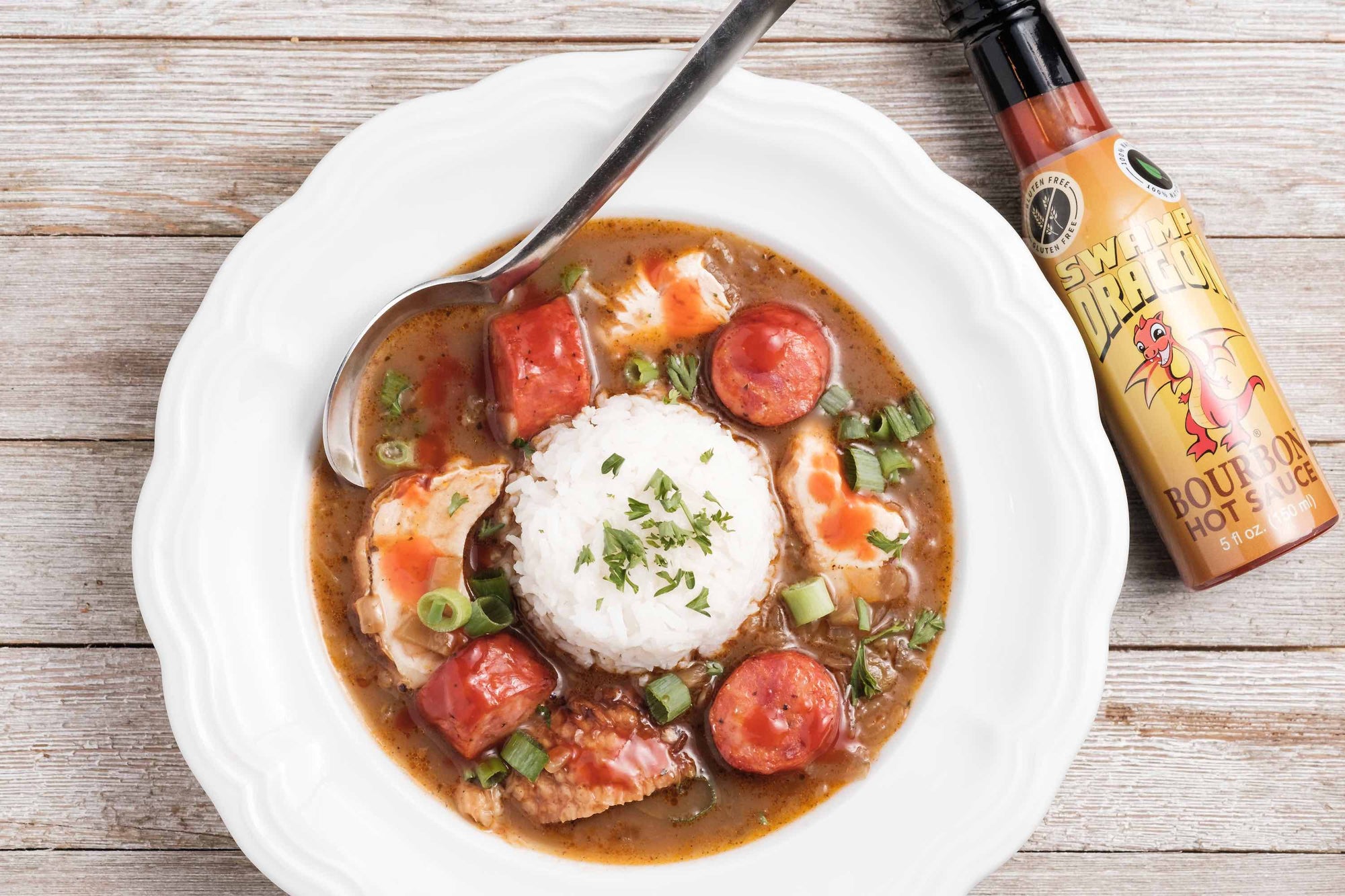Matt's Gumbo
October 10 2019 – Matt Beeson

This right here is part of the reason Swamp Dragon exists. When you go to this level of work to make gumbo that's as much art as food... well... you just do not put vinegar in it! NO!
The problem with writing this recipe is that I don’t work from a recipe. The best I can do is to try to explain and hope you get something out of it. I started when I was a teenager by reading and following one of Paul Prudhomme’s recipes, then I figured out the basics and adapted from there. I also messed up several batches over my storied cooking history.
Gumbo is a combination of four basic food structures: Meat, Stock, Trinity, and Roux.
Meat:
Make this whatever the hell you want, then name your gumbo after it. If you’re including sausage, go ahead and cut it all up the way you like and set aside. Cut and prep your other meats and set aside as well, reserving bones for stock. If you’re going all for scratch, roast your bird first, let cool, then debone it and use the bones for stock. Chuck the skin though, it’ll just make grease.
Popular meat combos include:
Duck and sausage (any smoked will do, but Andouille (pronounced “Ahndoowee”) is best.)
Chicken and sausage
Seafood (typically shrimp, crab, oyster, crawfish, etc, but not fish. Fish doesn’t work so well in gumbo, but we can talk about Court Bouillon (pronounced “Coobeeyahn”) some other time.)
Seafood and sausage
You can make stock, you can make a rich stock, or you can buy stock at the store. It all depends on what level of bragging rights you want and how much time you have. I’ve never heard of a beef gumbo, but I suppose it could be done.
Stock:
Bones, one quartered onion, two cloves whole garlic, about 1 tablespoon of black peppercorns, one or two stalks of celery. If you’re making chicken and sausage gumbo, use chicken bones; if you’re making seafood gumbo, use shrimp heads/shells and maybe a fish spine/head. Use a fish from the Gulf of Mexico. Salmon won’t do.
Place all the ingredients in a big pot. Fill with cold water and set to boil. Once a rolling boil is reached, turn down to slow boil and let it go as long as you want. Seafood stock really only needs about half and hour to an hour. Meat stocks can go all day. If you go for a really long time, be sure to add water as it boils down. This will condense and intensify your basic flavors.
Rich stock:
Same as above, but roast everything in a pan before you add the water, until everything begins to caramelize and marrow starts coming out of the bones. Deglaze your pan with some water and pour into the pot as well. Add one fresh, raw onion.
Store-bought stock:
Open the cans or the boxes and dump into a pot. Think you can handle that there, Sherlock?
OK, now the stock is going, let’s talk about the Holy Freaking Trinity of Cajun/Creole cooking: Trinity.
Trinity:
It’s called Trinity because it’s divine, it consists of three ingredients, and it’s in everything. It’s onions, bell peppers, and celery. It provides a basic seasoning, flavor, and color for Red Beans & Rice, Gumbo, Jambalaya, blah, blah, blah… Seriously, it’s in everything but dessert.
For gumbo, again, I don’t count/measure anything, I just fly without instruments.
One large onion (any kind will do, but we prefer Vidalia. Good luck finding them in the uncivilized badlands of Austin.). One large bell pepper, a couple of stalks of celery. You pretty much are looking for equal parts of each, and they all should be cut to a fairly small dice.
Heat some oil in a pan, enough to lube everything, and start cooking the onion and celery first (They take longer than the bell pepper). Once they get soft, add the bell pepper and cook till everything starts browning real pretty. We’re not cooking French here; we’re cooking Creole. The French cook through (mirepoix, not trinity - French weirdos), then stop. We cook till brown brown. Brown and mushy. Add two or three fresh bay leaves, and some Italian seasoning (maybe like a couple of teaspoons- I don’t really know). I like to add pepper, red, black, and white all in small doses at this point, but be careful here if your meat includes Andouille sausage, as it will spice things up quite a bit on its own. Once it’s all browned, you can turn the fire off and leave this stuff. The combination of 3 pepper types adds heat, but also flavor complexity. My favorite andouille is Savoie’s, and can be found at www.cajungrocer.com.
Roux:
OK, this shit scares everyone, because everyone thinks this is some kind of complicated high level cooking method, but it ain’t rocket surgery. It thickens the gumbo and gives it color and a very deep, rich, almost nutty flavor. Be careful though. You’ll be very unhappy if you get any on you. It’s called Cajun napalm for a reason.
You need a big skillet, cast iron is best, but any non-delicate (absolutely no Teflon!) thing will work. You need a long wire whisk. You need vegetable oil of some kind that has a high smoke point. I use Canola, but regular veggie oil will work. I used goose fat from a Thanksgiving goose, and made goose and andouille gumbo from the leftovers. Yum! No olive oil here. You need regular old fashioned flour. Stock is simmering, and has been for a while, our seasoning (Trinity) is prepped and browned, the kitchen looks like a Federal Disaster Zone, and you have everything ready to make a roux. Let’s get started.
Start with about a cup each of oil and flour. Put the oil in the skillet, and turn on the fire medium-high (or high, if you’re gonna be very attentive). As it’s warming up, add the flour and mix it in so there’s no lumps. As this stuff begins cooking, it’s going to start looking wetter and wetter. Add more flour slowly, mixing in as you go and looking to reach a pasty consistency. Do not stop stirring, ever. If this stuff looks greasy, it is; keep adding flour. Paste is the goal. If it goes in greasy, you’ll get greasy gumbo. Greasy gumbo ain’t the end of the world, but I always skim it if it’s greasy, and it’s just more work for nothing.
Now, as you stir, it’s going to start changing color-not so much at first, but it’s gonna speed up on you pretty quick as it gets real screaming hot. If you stop stirring, it’ll change color real real quick. It’ll be black, which means burnt, which means dump it out, wash everything and start over. Burnt roux tastes like charcoal that steeped in someone’s b-hole. In fact, if you see black specs in it, it’s burnt; start over. I like a deep brown roux, milk chocolate color. You’ll see it changing color quickly once it gets going. You need all your attention to get this right.
When it’s a shade or two lighter than your goal, turn off the fire, and start spooning this stuff into your trinity (or spoon your trinity into this stuff). It’s going to sizzle like crazy, and it’s going to instantly get a shade or two darker, but the trinity will stop the cooking of the roux. If you don’t stop it from cooking, it will burn whether the fire is on or not. You cannot just turn the fire off and walk away to get a smoke.
Almost there…
Strain your stock, which, if you’re following along, is still simmering, into another pot and return to boil. Discard the solids you strained out. Smack the cat. Once boiling, start adding roux/seasoning mixture with a big mixing spoon into the stock, taking care to dissolve each spoonful as you go. Once it’s all added, you can add your meat, and then reduce heat and cook slowly till the meat is nicely tenderized. If you’re doing seafood and sausage, cook the sausage for about half an hour, add shrimp, return to a low boil, then immediately turn the fire off. Add oysters, fold in crab, and just let sit for about ten minutes. These delicate seafoods will cook nicely without fire and boiling water. You want your seafoods to cook through and then stop cooking.
If you’re doing chicken, add sausage first, cook about 10-15 minutes, then add chicken and cook until everything’s nice and soft. Duck cooks longer than chicken to get to the same tenderness.
Final seasoning: Add Tony Chachere’s (More Spice version is best) and salt to taste. You can kinda go apeshit with the salt, but regular Chachere’s has plenty of salt in it. Do plenty of tasting as you go, but be sure to allow the Chachere’s and salt to integrate into the gumbo really well before each tasting. We haven’t added any salt at all till this point, because there’s so many variables with stocks, sausages, and such bringing their own salt content to the party. If you’re shy with it, the gumbo will be lame.
If you get a layer of grease on top, just skim. This stuff keeps great in the fridge and is often better the day after. Serve over rice.
Don’t forget the most important ingredient. Use a liberal sprinkling of LOVE!

0 comments